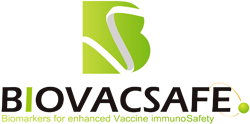Using a vaccine to probe the workings of the immune system
Vaccines work by triggering a mild and localised inflammatory response that will create the right environment to establish immunity against a given disease. However, excessive inflammation can result in serious complications. It is currently difficult to predict when severe inflammation will occur, and this has led to some vaccines being withdrawn from the market. Immediate reactogenicity (side effects) of vaccines, as well as rare or delayed side effects or adverse outcomes might not show up during clinical trials, and identifying safety issues when a vaccine is in late development or after licensing is expensive and causes delays and - most importantly - exposes populations to unexpected increased risk.
The BIOVACSAFE project was launched right about the time that new technological developments were changing the way scientists can study biological material. Genomics, proteomics and metabolomics and new ways of working with cell components helped the researchers look at vaccines in a new light. BIOVACSAFE wanted to understand whether the reactions, or ‘flags,’ that appeared in the days and weeks after a person has received a vaccination, could accurately predict what would happen to them in the longer term. This knowledge would help accelerate the development of a vaccine by, for example, making decisions more quickly on whether to pursue alternatives.
The project partners used systems vaccinology techniques to carry out their analyses. In systems vaccinology, scientists can evaluate a wide range of different parameters in order to churn out a huge amount of data that are then used to make interpretations about clinical endpoints (symptoms, signs) in an integrated way, as opposed to the more traditional descriptive way. A descriptive reading of data might be that, for example, the number of antibodies have increased; systems vaccinology techniques can demonstrate that the increase correlates, for example, with the expression of certain genes in a predictive way.
Most of the new methodologies are very sensitive, and it was important for the study investigators to be sure that if they find a ‘flag’ that it is indeed indicative of tolerability or reactogenicity. That’s why they chose to study vaccines for which we already know a lot, and for which there is a large clinical database of information on their tolerability and of mild or medium reactogenicity. There were two sites that carried out clinical trials with a limited number of subjects who each received either one of six vaccines or placebo.
The team carried out a deep analysis of a large set of immunological data molecular data to see whether there were signals that could have predicted the reactions that are known to be produced by these vaccines. With this, they were able to come up with a ‘threshold’ of signals that indicate that the vaccine is working.
A question of acceptability
An important question for the BIOVACSAFE project concerned acceptability; in most cases, vaccines are injected into a healthy person, and so questions about vaccine safety and tolerability are tied up with questions about acceptability of the vaccine by people. To what degree do individuals feel that the benefits of the vaccine outweigh unwanted side effects? A mild reaction might not be tolerated by people who are in good health, in many cases. BIOVACSAFE wanted to figure out the minimum required level of reactogenicity that the vaccine produces to induce a response, while also being considered tolerable by a healthy individual.
This is a very important question that is vital for making sure there is adequate uptake of any new vaccine. If ways can be found to reduce even a very mild reaction by dissecting the mechanisms by which they are elicited, while maintaining a good quality of immune response, confidence and acceptability of vaccines can be greatly increased in the future. This is a problem for which the project was able to contribute great insights and new knowledge.
At the same time, another BIOVACSAFE group were using the same vaccines in animal models in order to make sure that the signals obtained in humans were paralleled in animal models. The real value of using the animal models in parallel (as opposed to one after the other, as in traditional vaccine development) was that, paradoxically, by making sure that the animal models are more predictive of long-term effects, the number of animals used in research can ultimately be reduced, a sensitive issue for many Europeans.
What’s next
BIOVACSAFE was the first step towards this new generation of vaccines. The techniques tested in the project, though they are not routine, they are being used more and more. Similar omics techniques like those used in BIOVACSAFE are being applied in the development of the new COVID-19 vaccines. The larger the population receiving the vaccine, the higher the chance that concomitant episodes - episodes not associated with the vaccine - might occur, and the project partners are watching the outcomes of those vaccination campaigns closely. The project has established this expertise in Europe, which makes Europe more competitive in this regard.

